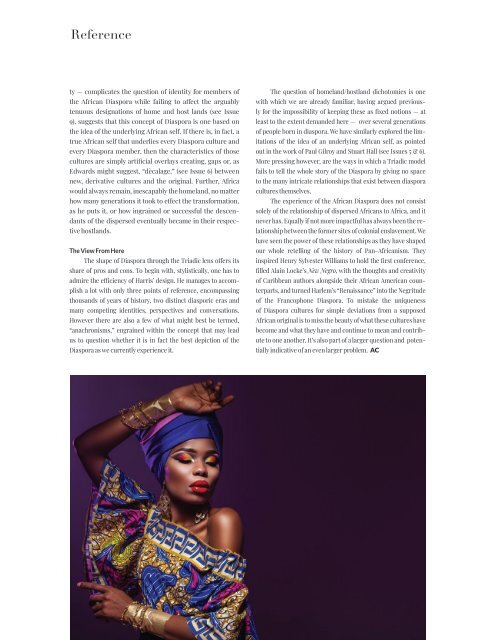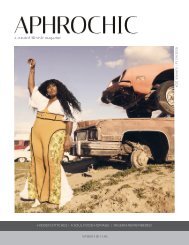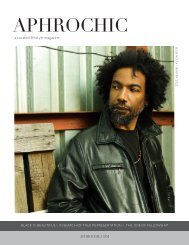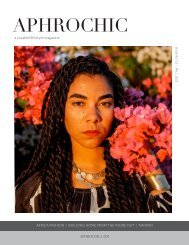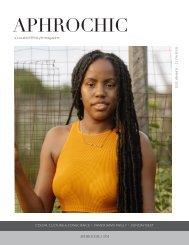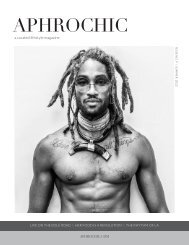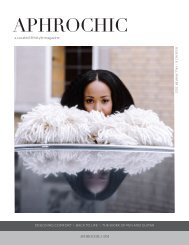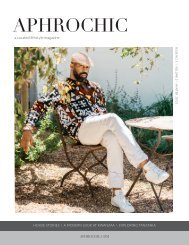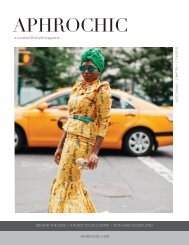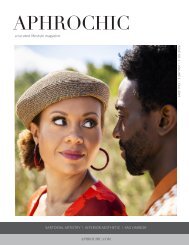AphroChic Magazine: Issue No. 11
You also want an ePaper? Increase the reach of your titles
YUMPU automatically turns print PDFs into web optimized ePapers that Google loves.
Reference<br />
ty — complicates the question of identity for members of<br />
the African Diaspora while failing to affect the arguably<br />
tenuous designations of home and host lands (see <strong>Issue</strong><br />
9), suggests that this concept of Diaspora is one based on<br />
the idea of the underlying African self. If there is, in fact, a<br />
true African self that underlies every Diaspora culture and<br />
every Diaspora member, then the characteristics of those<br />
cultures are simply artificial overlays creating, gaps or, as<br />
Edwards might suggest, “dècalage,” (see <strong>Issue</strong> 6) between<br />
new, derivative cultures and the original. Further, Africa<br />
would always remain, inescapably the homeland, no matter<br />
how many generations it took to effect the transformation,<br />
as he puts it, or how ingrained or successful the descendants<br />
of the dispersed eventually became in their respective<br />
hostlands.<br />
The View From Here<br />
The shape of Diaspora through the Triadic lens offers its<br />
share of pros and cons. To begin with, stylistically, one has to<br />
admire the efficiency of Harris’ design. He manages to accomplish<br />
a lot with only three points of reference, encompassing<br />
thousands of years of history, two distinct diasporic eras and<br />
many competing identities, perspectives and conversations.<br />
However there are also a few of what might best be termed,<br />
“anachronisms,” engrained within the concept that may lead<br />
us to question whether it is in fact the best depiction of the<br />
Diaspora as we currently experience it.<br />
The question of homeland/hostland dichotomies is one<br />
with which we are already familiar, having argued previously<br />
for the impossibility of keeping these as fixed notions — at<br />
least to the extent demanded here — over several generations<br />
of people born in diaspora. We have similarly explored the limitations<br />
of the idea of an underlying African self, as pointed<br />
out in the work of Paul Gilroy and Stuart Hall (see <strong>Issue</strong>s 5 & 6).<br />
More pressing however, are the ways in which a Triadic model<br />
fails to tell the whole story of the Diaspora by giving no space<br />
to the many intricate relationships that exist between diaspora<br />
cultures themselves.<br />
The experience of the African Diaspora does not consist<br />
solely of the relationship of dispersed Africans to Africa, and it<br />
never has. Equally if not more impactful has always been the relationship<br />
between the former sites of colonial enslavement. We<br />
have seen the power of these relationships as they have shaped<br />
our whole retelling of the history of Pan-Africanism. They<br />
inspired Henry Sylvester Williams to hold the first conference,<br />
filled Alain Locke’s New Negro, with the thoughts and creativity<br />
of Caribbean authors alongside their African American counterparts,<br />
and turned Harlem’s “Renaissance” into the Negritude<br />
of the Francophone Diaspora. To mistake the uniqueness<br />
of Diaspora cultures for simple deviations from a supposed<br />
African original is to miss the beauty of what these cultures have<br />
become and what they have and continue to mean and contribute<br />
to one another. It’s also part of a larger question and potentially<br />
indicative of an even larger problem. AC


